
The Ural, known before 1775 as the Yaik, is a river flowing through Russia and Kazakhstan in the continental border between Europe and Asia. It originates in the southern Ural Mountains and discharges into the Caspian Sea. At 2,428 kilometres (1,509 mi), it is the third-longest river in Europe after the Volga and the Danube, and the 18th-longest river in Asia. The Ural is conventionally considered part of the boundary between the continents of Europe and Asia.

Chelyabinsk Oblast is a federal subject of Russia in the Ural Mountains region, on the border of Europe and Asia. Its administrative center is the city of Chelyabinsk.

Orenburg, formerly known as Chkalov (1938–1957), is the administrative center of Orenburg Oblast, Russia. It lies in Eastern Europe, on the banks of the Ural River and is 1,478 kilometers (918 mi) southeast of Moscow.

Orsk is the second largest city in Orenburg Oblast, Russia, located on the steppe about 100 kilometers (62 mi) southeast of the southern tip of the Ural Mountains. The city straddles the Ural River. Population: 239,800 (2010 Census); 250,963 (2002 Census); 270,711 (1989 Census). It lies adjacent to the Kazakhstan–Russia border.

Ural Economic Region is one of twelve economic regions of Russia. This prominent industrial region consists of the following subdivisions : Bashkortostan (Ufa), Chelyabinsk Oblast (Chelyabinsk), Kurgan Oblast (Kurgan), Orenburg Oblast (Orenburg), Perm Krai (Perm), Sverdlovsk Oblast (Yekaterinburg) and Udmurt Republic (Izhevsk). It is mostly located in the Central, and partly in the Southern and Northern parts of the Urals, but also includes parts of the East European and West Siberian Plains. Its extent is different from that of the Ural Federal District; Bashkortostan, Orenburg Oblast, Perm Krai and Udmurtia are in the Volga Federal District while the other three are in the Ural Federal District.
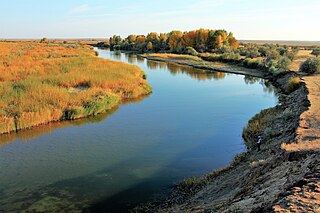
The Ilek is a river in the Aktobe Region, Kazakhstan, and Orenburg Oblast, Russia. It is 149 kilometres (93 mi) long, and has a drainage basin of 13,700 square kilometres (5,300 sq mi).
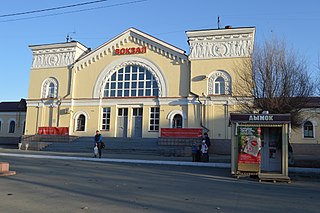
Novotroitsk is a town in Orenburg Oblast, Russia, located on the right bank of and along the Ural River, 276 kilometers (171 mi) from Orenburg, on the border with Kazakhstan. In the east Novotroitsk almost borders Orsk: the distance between the two cities is less than 2 kilometers (1.2 mi). Population: 98,173 (2010 Census); 106,315 (2002 Census); 106,084 (1989 Census).

Ural is a geographical region located around the Ural Mountains, between the East European and West Siberian plains. It is considered a part of Eurasian Steppe, extending approximately from the North to the South; from the Arctic Ocean to the end of the Ural River near Orsk city. The border between Europe and Asia runs along the Eastern side of the Ural Mountains. Ural mostly lies within Russia but also includes a small part of Northwestern Kazakhstan. This is historical, not an official entity, with borders overlapping its Western Volga and Eastern Siberia neighboring regions. At some point in the past, parts of the currently existing Ural region were considered a gateway to Siberia, or even Siberia itself, and were combined with the Volga administrative the divisions. Today, there are two official namesake entities: the Ural Federal District and the Ural economic region. While the latter follows the historical borders, the former is a political product; the District omits Western Ural and includes Western Siberia instead.
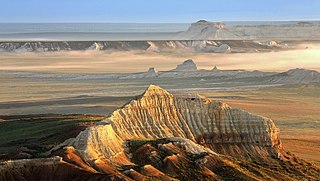
Aktobe Region is a region of Kazakhstan. The name Aktobe comes from Kazakh aq 'white' and töbe 'hill' or 'top '; supposedly, Aktobe's initial settlers were able to see white mountains far to the north. The Aktobe regional capital is the city of Aktobe. The region is located in the western part of Kazakhstan. Its area is 300,629 km2, which is 11 per cent of the territory of Kazakhstan. The population is 909 673 as of June 1, 2022.
The Or is a river in Orenburg Oblast of Russia and Aktobe Province of Kazakhstan. It is a left tributary of the Ural, and is 332 km long, with a drainage basin of 18 600 km2. The river is formed by the confluence of the rivers Shiyli and Terisbutak, which have their sources on the western slopes of the Mugodzhar Hills, and it joins the Ural by the city of Orsk. Most of its discharge are from melting snow. The average discharge, 61 km from its mouth, is 21.3 m³/sek. The spring flooding lasts from April to mid-May. The rest of the year the waterlevel is very low. The river freezes in late October and is icebound until March - April. The river is used for irrigation and water supply.
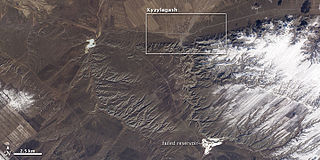
The Kyzyl-Agash Dam failure, occurred in a dam located outside the village of Kyzyl-Agash, Jetisu Region, Kazakhstan. On 11 March 2010, the dam burst, flooding the village. At least 43 people were killed, 211 people were injured, and over 1000 evacuated from the village.

The Kazakhstan–Russia border is the 7,644-kilometre (4,750 mi) international border between the Republic of Kazakhstan and the Russian Federation. It is the longest continuous international border in the world and the second longest by total length, after the Canada–United States border. It is in the same location as the former administrative-territorial border between the Kazakh Soviet Socialist Republic and the Russian Soviet Federative Socialist Republic.
Orenburzhie is a commercial airline headquartered in Orenburg, Russia, on the ground of Orenburg Airport. It serves as regular and charter passenger airline out of Orenburg and Izhevsk Airport.
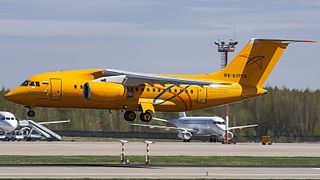
Saratov Airlines Flight 703 was a domestic passenger flight from Moscow Domodedovo Airport to Orsk Airport in Russia. On 11 February 2018, the aircraft serving the flight, an Antonov An-148-100B, crashed shortly after take-off, killing all 71 people on board – 65 passengers and six crew members.
The Orenburg Independent Army was an anti-Bolshevik Army on the Eastern Front during the Russian Civil War.
Valeriy Nikolayevich Andreev, known as the Orsk Maniac, is a Russian serial killer and rapist responsible for the abductions, rapes and killings of various girls and women in Orenburg Oblast from 2006 to 2012. Investigators have conclusively tied him to at least 7 murders, after which he was put on a wanted list, but managed to escape. As of 2023, he remains one of the twelve most dangerous criminals wanted by the Ministry of Internal Affairs of Russia. In total, police suspect his involvement in the disappearances of more than 100 girls and women.

Aleksandr Borisovich Kogan is a Russian political figure and deputy of the 8th State Duma. In 2005, he was granted a Candidate of Sciences in Economics degree.

Russian occupiers carried out a series of artillery fire and air raids in the city of Kryvyi Rih during the Russian invasion of Ukraine.
Events in the year 2024 in Russia.
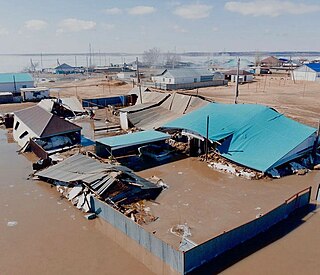
In April 2024, extensive flooding impacted several regions of Kazakhstan and Russia, specifically in the Ural Mountains and Siberia. Snow melt caused freshets resulting in the Orsk Dam collapsing. In Russia, a federal emergency was declared. Hundreds of thousands of people were evacuated including 16,000 people in Kazakhstan. At least eight people died and hundreds of livestock have drowned in floods that are described to have inundated an area the size of western Europe.















